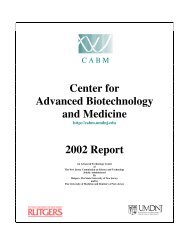Annual Report 2011 - Center for Advanced Biotechnology and ...
Annual Report 2011 - Center for Advanced Biotechnology and ...
Annual Report 2011 - Center for Advanced Biotechnology and ...
Create successful ePaper yourself
Turn your PDF publications into a flip-book with our unique Google optimized e-Paper software.
Dr. Gaetano Montelione<br />
CABM Resident Faculty Member<br />
Jerome <strong>and</strong> Lorraine Aresty Chair in<br />
Cancer Biology Research<br />
Professor II<br />
Department of Molecular Biology <strong>and</strong><br />
Biochemistry<br />
Rutgers University<br />
Adjunct Professor<br />
Department of Biochemistry<br />
UMDNJ-RWJMS<br />
Director<br />
Northeast Structural Genomics<br />
Consortium<br />
Dr. Swapna Gurla<br />
Associate Research Professor<br />
Dr. Yuanpeng Huang<br />
Associate Research Professor<br />
Dr. Roberto Tejero<br />
Visiting Professor<br />
Dr. Thomas Acton<br />
Assistant Research Professor<br />
Dr. James Aramini<br />
Assistant Research Professor<br />
Dr. John Everett<br />
Assistant Research Professor<br />
Dr. Rongjin Guan<br />
Assistant Research Professor<br />
Dr. Gregory Kornhaber<br />
Assistant Research Professor<br />
Structural Bioin<strong>for</strong>matics Laboratory<br />
Dr. Gaetano Montelione did graduate studies in protein physical chemistry with<br />
Professor Harold Scheraga at Cornell University. He learned nuclear magnetic<br />
resonance spectroscopy at the Swiss Federal Technical Institute in Zürich where he<br />
worked with Nobel laureate Dr. Kürt Wüthrich, the first researcher to solve a protein<br />
structure with this technique in 1985. Two years later, Dr. Montelione solved the<br />
structure of epidermal growth factor. He has developed new NMR techniques <strong>for</strong><br />
refining 3D structures of proteins <strong>and</strong> triple resonance experiments <strong>for</strong> making 1 H,<br />
13 C, <strong>and</strong> 15 N resonance assignments in intermediate-sized proteins. He has served as<br />
a member of the NSF Molecular Biophysics Study Section, NSF Committee of Visitors,<br />
NSF Advisory Committee <strong>for</strong> Biological Sciences (BIO AC) <strong>and</strong> advisor to the World<br />
Wide Protein Data Bank (WW_PDB). Dr. Montelione has received the Searle<br />
Scholar Award, the Dreyfus Teacher-Scholar Award, a Johnson <strong>and</strong> Johnson<br />
Research Discovery Award, the American Cyanamid Award in Physical Chemistry,<br />
the NSF Young Investigator Award, <strong>and</strong> the Michael <strong>and</strong> Kate Bárány Award of the<br />
Biophysical Society. He is an elected Fellow of the American Association <strong>for</strong> the<br />
Advancement of Science.<br />
As director of the NIH-funded Northeast Structural Genomics Consortium of the<br />
NIGMS Protein Structure Initiative, Dr. Montelione leads an inter-institutional pilot<br />
project in large-scale structural proteomics <strong>and</strong> bioin<strong>for</strong>matics. Goals of our work<br />
involve developing high-throughput technologies suitable <strong>for</strong> determining many new<br />
protein structures from the human genome project using nuclear magnetic resonance<br />
spectroscopy (NMR) <strong>and</strong> X-ray crystallography. These structures provide important<br />
insights into the functions of novel gene products identified by genomic <strong>and</strong>/or<br />
bioin<strong>for</strong>matic analysis. The resulting knowledge of structure <strong>and</strong> biochemical function<br />
provides the basis <strong>for</strong> collaborations with academic laboratories <strong>and</strong> pharmaceutical<br />
companies to develop drugs useful in treating human diseases that are targeted to these<br />
newly discovered functions. The approach we are taking is opportunistic in the sense<br />
that only proteins which express well in certain expression systems are screened <strong>for</strong><br />
their abilities to provide high quality NMR spectra or well-diffracting protein crystals.<br />
Those that provide good NMR or X-ray diffraction data are subjected to automated<br />
analysis methods <strong>for</strong> structure determination. The success of our approach relies on our<br />
abilities to identify, clone, express <strong>and</strong> analyze several hundred biologically interesting<br />
proteins per year; only a fraction of the initial sequences chosen <strong>for</strong> cloning <strong>and</strong><br />
analysis result in high-resolution 3D structures. However, this “funnel” process is<br />
yielding three-dimensional structures <strong>and</strong> new functions <strong>for</strong> some 200 proteins per year,<br />
<strong>and</strong> can thus have tremendous scientific impact. Research areas include networks of<br />
proteins associated with human cancer biology, protein complexes involved in<br />
influenza virus infection, innate immune response, <strong>and</strong> ubiquitination pathways.<br />
54



